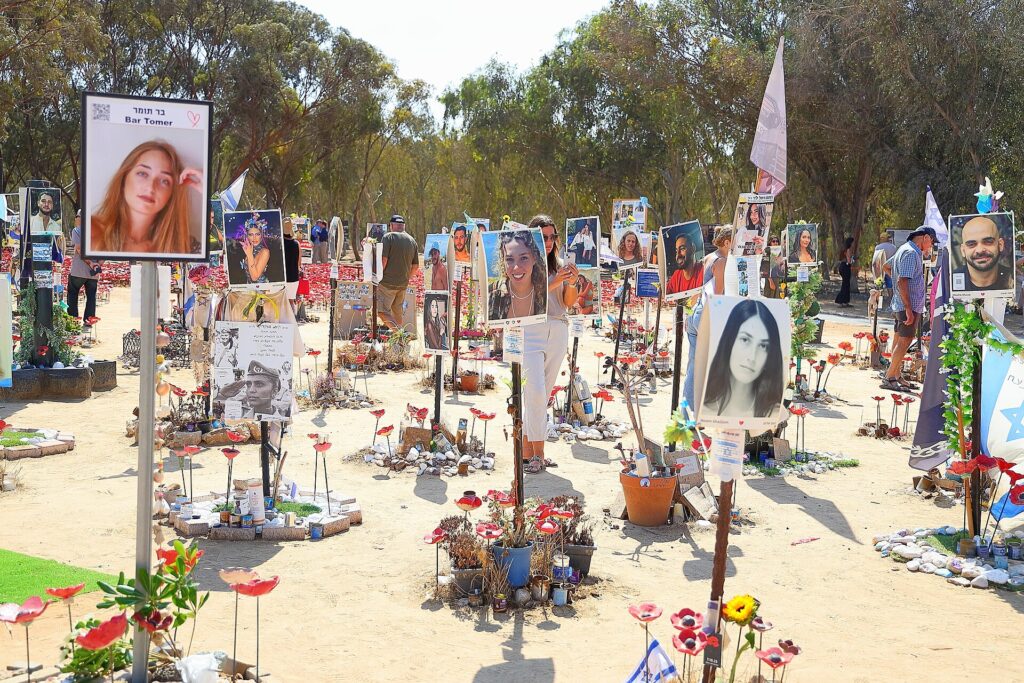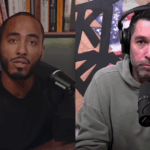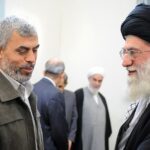Historical Essays, Reviews
Review: Israel and the Future of Civilization
Douglas Murray’s On Democracies and Death Cults: Israel and the Future of Civilization begins with an observation about the October 7 terrorist attack on Israel that those on all sides of the debate can surely agree with: “Sometimes a flare goes up and you get to see exactly where everyone is standing.”
I expected Murray’s book to be a personal eyewitness account of his time with the IDF on the frontlines of the war in Gaza. It is not. Aside from a few anecdotes—including a powerful reflection on his visit to the bombed-out building in Rafah where October 7 architect Yahya Sinwar bled out and breathed his last—this book is primarily a reconstruction of the atrocities of October 7 and the global spasm of Jew-hatred that followed.
There are those who might wonder if such a book is necessary almost two years later. There have been press reports; documentaries such as We Will Dance Again and One Day in October; several books. Murray makes it clear that the answer is yes, and the testimonies of survivors and grieving loved ones are difficult to read, despite what I already knew. This horror was a flare, and in its grim light, the response of so many to that horror showed us where they were—and are.
Many wish to ignore the response to October 7 and hurry on to a condemnation of Israel’s war in Gaza. Their reaction goes something like this: Yes, yes, October 7 was bad, of course. But we must frame that bad event with what came before, and after. It is true that context is important. But only by first understanding the reaction to October 7 can we understand what is going on now, and only by listening to the words of those who perpetrated it is it possible to understand what Israel is doing and believes it must do.
In short: We cannot hurry past the response to October 7, because it told us much about the motives of those currently condemning Israel, and because many are not only unwilling to say that that the atrocities of October 7 were bad, but are happy to say the opposite—frequently into bullhorns, at such a high volume that those who have not noticed this are doing so deliberately. An assumption of good faith is essential to a productive conversation. The collapse of good faith eliminates the possibility of productive conversation. The response to October 7 was a stark revelation of insidiously bad faith.
Murray describes witnessing a rally in opposition to Israel in Times Square, New York, while the Hamas attacks on that country was still ongoing. Some signs celebrated the orgy of rape and murder. Across the West, rallies in celebration of October 7 and in support of Hamas unfolded that weekend. I detailed the response of anti-Israel activists and academics for The European Conservative on October 10. Why do these dates matter? Because it is essential context for the debate we are seeing now, when many of these same people are attempting to claim that they do not wish harm on the Jews and that they merely oppose the Israeli response.
They must not be permitted to get away with this lie, and Murray does not let them. These people must not be allowed to hide behind their claims about simply opposing the war in Gaza, when they were at the barricades to celebrate atrocities before a single IDF soldier had set foot there. Hamas raped, burned, and killed their way into a horrific war—and across the West, people stood behind them—then. There are many tragedies to discuss and debate. But many of Israel’s opponents cheered the destruction of her civilians while they were still dying. Many, by their own admission, do not think that Israel should exist—not as a matter of historical argument, but of current policy.
Murray provides additional, essential context that explains why Israel’s second war aim (after retrieving the hostages) is the destruction of Hamas in Gaza. He details the 2005 withdrawal of Israel from Gaza, the subsequent and ongoing barrage of rockets (between 20,000 and 30,000 rockets and mortars), the creation of a terrorist state committed to Israel’s obliteration on her border, and the words of Hamas leaders, committing to perpetrate the same crimes, again and again, until Israel is destroyed.
On October 24, 2023, senior Hamas leader Ghazi Hamad told Lebanon’s LBC TV: “We will repeat the October 7 attack time and again until Israel is annihilated. We are victims of the occupation. Period. Nobody should blame us for the things we do. On October 7, October 10, October one-millionth, everything we do is justified.” The journalist asked: “Occupation of Gaza?” Hamad replied: “No. All of Israel.”
The Israelis believe him. Any critic of their military objective to destroy Hamas must answer the questions: Do you believe him? If not, why not? Can Israel be expected to disbelieve him? It is one thing to criticize how Israel is conducting the war. There are many vociferous critics inside Israel doing just that. It is quite another to reject the war aim of destroying Hamas, a government that has not only committed atrocities, but promised publicly to finish the job should they ever have the means to do so.
Murray cites the observation of his friend the late George Weidenfeld, a publisher and member of the British House of Lords, that the antisemitism he saw in the Islamic world may be worse than that of the Nazis. Weidenfeld, contrary to the claims of the those who perpetually demonize all Jewish people as anti-Christian, spent his last years using his own fortune to free Yazidi and Christian captives enslaved by ISIS. I interviewed him about it shortly before he died, and he told me that Christians had saved him from the Nazis, and he was trying to return the favor wherever he could.
Weidenfeld spent decades trying to understand Nazi antisemitism and controversially published several Nazi memoirs in that pursuit. The Nazis, he noted, tried to hide their crimes. Indeed, Heinrich Himmler gave a speech to the SS in Poland in 1943, explaining that the destruction of the Jews “is a page of glory in our history which has never been written and is never to be written.” But the terrorists of Hamas, conversely, broadcast their atrocities. They livestreamed them on the internet for all to see, often from the phones of their murdered victims. Murray quotes one exchange, in which a Hamas militant calls his parents on October 7:
Mahmoud: “Hello, Dad!”
Father: “Mahmoud, where are you?”
Mahmoud: “I’m in Mefalsim. Dad, I killed 10 Jews with my own hands! I’m using the phone of a Jew I killed. Look at my WhatsApp, I sent you pictures. I killed them, Dad!”
Father: “Allahu Akbar! My son, Allahu Akbar!”
Mahmoud: “Check my status, Dad, see the pictures! I’m a hero now!”
Mother (in the background): “My son, you make us proud!”
Mahmoud: “I’m inside their house, I killed her and her husband. I’m sending you the video.”
Father: “May Allah protect you, my son. You are a lion!”
Mahmoud: “I swear, Dad, I killed 10 with my own hands! Open WhatsApp now!”
Father: “Allahu Akbar, you’re a hero! Keep going!”
Hamas did not hide their crimes. They publicized them. They paraded the battered bodies of young women down the streets of Gaza to cheering crowds. This, too, happened before the Israeli military operation in Gaza—although I suspect that those cheering the murder of Jews were unaware of the fact that Hamas had not only factored the deaths of civilians into their war aims, but that intercepted messages between leadership figures has affirmed that the deaths of civilians were one of their war aims. It is a simple and brutally effective strategy: Embed terrorists and hostages within the civilian population, and Israel will be delegitimized by the civilian casualties incurred in their attempt to root them out and rescue the kidnapped.
In some of the most eloquent passages in the book, Murray also grapples with the age-old question: Why the Jews? Why does antisemitism re-emerge, generation after generation, in different forms? For the antisemite, it is a self-answering question. Their hatred justifies itself. Because we keep finding reasons to hate the Jews, obviously there is something to hate about the Jews. As Murray observes, antisemitism is a shapeshifter. The Jews have been hated for being too poor, and for being too rich. For being too religious, and too secular. For being stateless, and for having a state. It is difficult not to conclude that antisemitism is a spiritual sickness.
Murray is referencing the late Rabbi Jonathan Sacks, who noted that this shapeshifting allows “new antisemites [to] deny that they’re antisemites at all because their hate is different from the old.” As Sacks stated in a 2016 speech to European Parliament:
Antisemitism means denying the right of Jews to exist collectively as Jews with the same rights as everyone else. It takes different forms in different ages. In the Middle Ages, Jews were hated because of their religion. In the nineteenth and early twentieth century they were hated because of their race. Today they are hated because of their nation state, the state of Israel. It takes different forms, but it remains the same thing.
That historical context is lived experience for every Jewish person in the West, a collective memory that triggers their internal alarm system when they see the echoes of their bloody past in a wave of Jew-hatred from both Left and Right online and chanted at rallies in Western capitals. That is why we see both antisemitism and the Jewish commitment to Zionism—and the idea that Jews can only be safe in a Jewish state defended by Jews—rise in tandem. Those who insist that antisemitism must be valid because it constantly resurfaces unconsciously prove the necessity of the State of Israel for Jewish people who justifiably look at them and think: It is happening again, and it will be you this time.








